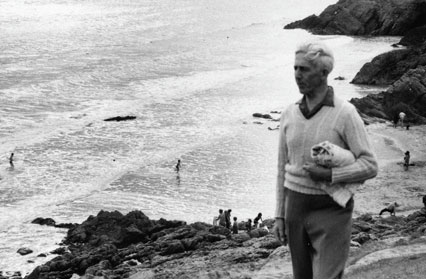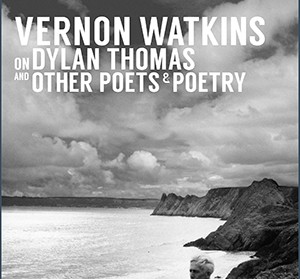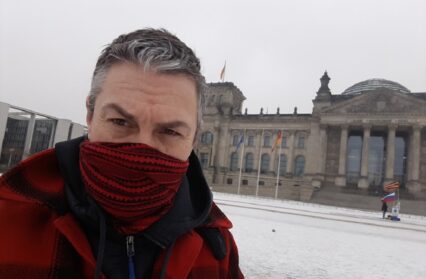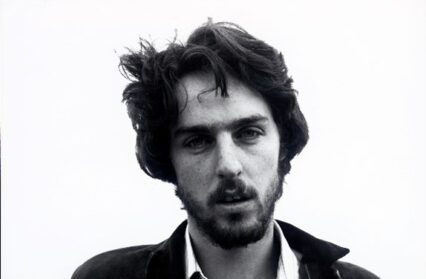Peter Gaskell reviews Vernon Watkins on Dylan Thomas and Other Poets and Poetry, a revealing account of the genesis of an artist.
Dylan Thomas called Vernon Watkins the most profound and greatly accomplished Welshman writing poems in English. One wonders therefore why he is not more celebrated. Not that it would bother him, being famous for his aphorism that reputation is the enemy of poetry.
This book does not contain more than a few lines of Watkins’ poetry. He cites them in relation to particular experiences, though his rationale for selecting them, whether for being his favourite lines or the significance of the related experiences is uncertain. What is clear is that he contributed much to help other poets fulfil their potential, Dylan Thomas in particular. Insight into his approach to literary criticism is well provided in the introduction by David Wright who had known Watkins since the late forties. Not a critic in the academic tradition, Watkins was insistent that his critique of others’ work was purely from a poet’s perspective.
In his foreword to this book, Rowan Williams expresses his hope that the essays of Vernon Watkins will have a twofold impact. Their publication by Parthian should prompt re-evaluation of his poetic output with fresh eyes, and stimulate new kinds of attention to the poetic work of many other poets.
For the first, most revealing is the essay ‘Poetry and Experience’, in which he describes his genesis and development as a poet from the age of nine. Influenced mainly by the romantic poets, he found his paradigm while still a young man in Yeats, who taught him how a poet should grow old without losing any freshness or intensity of vision. Then he met Dylan Thomas with whom he found deep affinity. Watkins believed all great art was dictated or suggested by higher powers than those of humanity and that like him, Dylan Thomas was a religious poet who believed that a poem would not exist at all but for ‘divine accident’. There was great friendship and no rivalry between them. They were complementary although their styles and methods were completely different, Dylan Thomas ‘working outward from a colloquial core of texture, I working towards the concrete from a musical or articulated source.’ Rowan Williams compliments the ‘disciplined intricacy and metaphorical freshness’ of Watkins’ poems. This is doubtless the effect on him of Yeats to whom Williams might equally well refer. Yeats was ‘the supreme poet of our age’, an opinion shared by Dylan Thomas.
In her afterword, his widow Gwen states that Watkins wrote more about poets and the writing of poetry than any poet before or after Wordsworth. Other poets subject to his critical assessment include Hardy, Milton, Auden, Housman, Heine, Sassoon, Eliot, Larkin, as well as the lesser known Charles Williams and Alun Lewis, but almost one hundred pages of this book are devoted to his writing about Dylan Thomas. Comprising eight articles, they are a fascinating blend of exposé, analysis, historical contextualisation, personal anecdote, insight into Dylan Thomas’ approach to writing and his personality.
The personal quality Dylan Thomas prized most was seriousness yet he was a born clown who loved to entertain. Like Dickens, he was an ‘astonishing mimic’ who could bring his stories alive when he read his prose aloud using different character voices. As radio broadcaster he would take off his coat ‘for he used a great deal of invisible gesture but on television he felt physically uneasy and kept it on.’ Watkins leans on the Yeatsian metaphor of the mask to present the complexity of Dylan Thomas’ character. His prose with all its humorous invention was made by his social life ‘for he loved people, his poetry by his isolation in spite of that, the isolation of the entertainer who has taken off his mask. His infectious humour deceived everyone but himself. His method was not to retreat from the mask but to advance beyond it and in that exaggeration remain completely himself.’
Although their relationship was mutually supportive, they did not always agree. Dylan Thomas loved films, even bad ones, while Vernon Watkins considered ‘cameras do not want art… they have no time for it. Art does not need cameras’. When Dylan Thomas suggested some changes to a poem Watkins had written in dialogue form, he refused to alter it on the grounds that the words of the poem were true. Dylan Thomas replied, ‘You can say to me that effectiveness is less than truth; I can only say that truth must be made effectively true and though every word of the truth be put down, the result may well be a clot of truths.’
Dylan Thomas was modest about his poetry but privately very sure of them. He was a slow and patient craftsman. There is no work so hard as writing poems, he said. When looking for an adjective in his poetry, he would try fifty or a hundred and reject them all. ‘He studied with great diligence the effect of word-linkings as matched a rooted common experience to anarchy and the element of surprise.’
Watkins is rarely microscopic in his analysis without weaving in personal anecdote. The best examples of these are his essays ‘Research and Reperception’ about Thomas’ ‘Poem to Caitlin’, and ‘Eight poems by Dylan Thomas’, a narration of how some of his best known poems underwent redrafting, often after consultation with Vernon Watkins. A line such as ‘I advance for as long as forever is’ that concludes the poem ‘Twenty-four Years’ was once part of a poem he had written much earlier. Being acutely self-critical, however fond he was of a line or phrase, he would scrap it if it did not fit and wait till he found the proper vehicle for it. ‘Llaregyb’ was coined in Dylan Thomas’ early prose drafts influenced by his favourite prose writer James Joyce but it would not appear until Under Milk Wood was broadcast at the end of his life.
A poem, says Watkins, is made magic which comes to the poet in the course of composition but one should not underestimate the laborious preparation for that possibility. To illustrate this, he cites Dylan Thomas’ ‘It Was My 30th Year To Heaven’ as ‘an intuitively perfect poem’, remarking that its apparently effortless utterance is deceptive. Over a hundred drafts were made. He remembers Dylan Thomas years before saying ‘I know the beginning of my next poem. It will be “It Was My 27th Year To Heaven”.’
Watkins’ term for this laborious process is ‘second pressure…where true spontaneity, true art seems to come, more often than not, long after the poem’s first conception; it is the more powerful for being delayed and the purer for having been tried in the furnace of contraries.’ Dylan Thomas’ later work was the result of this process. His development as a poet underwent a transfiguration when his subjective earlier work comprising stories full of symbols and surrealism was replaced by a more condensed style. It started with ‘Once It Was The Colour Of Saying’ in 1938 to reach its fullest articulation in Under Milk Wood. This work reflected his portrayal of human beings for themselves rather than as figures in a boy’s dream. Vernon Watkins again gives credit to Yeats as an influence on Dylan Thomas for this change of style.
Although the title does not refer, there are essays too on art and drama. ‘In Defence of Sound’ eschews television as a dramatic medium in favour of radio, since ‘the true theatre is the mind’s eye and the true action of the theatre springs from solitude and darkness’. In three essays on art and artists in Wales, after declaring his own ineptitude and inexpertise about art, Watkins writes about the value of art in all forms, elaborating on Ezra Pound’s dictum that ‘artists are the antennae of the race’. His belief is that since 1935 a new tradition in Wales has been initiated by Augustus John and others including members of his artistic fraternity in Swansea, the Kardomah Boys. These essays feature Alfred Janes, whom Dylan Thomas humourously described as a ‘blizzardly painter’ for his painstakingly slow work rate; writer, as well as artist, David Jones with the talent to ‘see as contemporary what is ancient and to see as ancient what is before his eyes’, and Ceri Richards who painted ‘Homage to Dylan Thomas’ as well as paintings inspired by Watkins’ poems.
This book will be of great value to both critics and aspiring poets who ‘must wait for art to make possible a true equivalent to life’. Watkins said the purpose of poetry is joy and his poems rest on ‘the paradox of life being given back in imperishable terms after it had been logically surrendered to time and death. A true poem creates the illusion that it has always existed and it was waiting only for the poet to write it down.’ However contemptuous he was of reputation, Watkins would surely be pleased if posterity considers his work conjures such illusion.
You might also like…
In the second of Jasper Rees’ interviews centred around the celebrations of Dylan Thomas’ centenary, for National Eisteddfod Archdruid, T James Jones discusses the poets’ ‘Welshness’, as well as his own translations of Under Milk Wood into Welsh.
This piece is part of Wales Arts Review’s collection, Dylan Thomas from the Archive.
Peter Gaskell is a contributor to Wales Arts Review.













